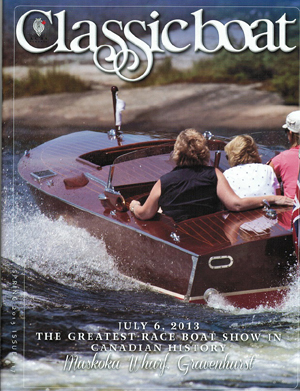
LAMP and the LAMP Boatworks is featured in the Fall 2013 issue of Classicboat Magazine, the publication of the Toronto Chapter of the Canadian Antique and Classic Boat Society.
The article does not appear to be online, though the previous issue does feature its articles online, so it may appear there in the future. But I’ll give you a little teaser here . . .
In addition to the Lighthouse, there are a number of smaller buildings on the site, and a few of those house the Lighthouse Archaeological Maritime Program (LAMP) which conducts and studies old maritime wrecks. They bring artifacts up from their resting place on the bottom of the Atlantic Ocean, and, in some cases, the wrecks are chemically and electrically stripped of their salt water scale and corrosion for study and documentation.
. . . . In 2007 a plan was put into motion to start up a volunteer group to build these small boats. Maury Keiser took up the challenge and the lead to assemble and start up a small group of volunteers. Like most groups, they evolved and found their way. Start up funds and continuing revenue sources are always an ongoing challenge. The idea was and still is to build a continuing and expanding group that, with experience, will develop a more complex skill set in traditional boatbuilding. As more volunteers enter the program, these skills are passed and shared.
I love the personal touch of the writer, one of our boatbuilding volunteers named Bryan Rhodes who is from Canada and spent the winter down here with his wife, when sharing his own experiences with us:
When we were considering where to spend part of the winter of 2013, we researched the St. Augustine area. On the Lighthouse web site, I saw a call for volunteers and put in an application. Kathy [the writer’s wife, and editor of Classicboat] was very happy to see that I would be out of the condo three mornings a week from 9:00 to 12:00 for the two months we were wintering in Florida. When I walked into the small outdoor boat building area I was welcomed and put to work–at first sanding, then applying varnish, then other project tasks. As the group became comfortable with what I could do, they let me take the lead refurbishing a small project rowboat. My time in Florida was up before the boat was completed, but it has since been finished.
The quality of the work is to a high standard. I wasn’t surprised as most of the guys are retired. So you have a group of accomplished retired people with good tools (their own for the most part), a desire to learn, no project deadline pressure to meet, and a good since of humour. None of the group was a professional boat builder before starting at LAMP, but all like the challenge that the boats present every day . . .
A large number of Canadians dropped in, and, being the only Canadian, I was introduced to most of them. They shared stories of their boats and Florida travels . . . School tours dropped by and the kids sure did ask a lot of questions. Some of these Atlantic coast kids didn’t realize that boats were and still are built of wood. The message of wooden boats is getting out there to these kids to the benefit of our hobby’s future. If one were looking to start up a boat building program, this seems like a decent model to follow.
We miss Bryan and Kathy Rhodes, who are back in Canada. We hope to see you again soon, and thanks for such a great article!

